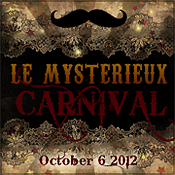---------------------------------------------------------------------
A freak show is an exhibition of biological rarities, referred to as "freaks of nature". Typical features would be physically unusual humans, such as those uncommonly large or small, those with both male and female secondary sexual characteristics, people with other extraordinary diseases and conditions, and performances that are expected to be shocking to the viewers. Heavily tattooed or pierced people have sometimes been seen in freak shows, as have attention-getting physical performers such as fire-eating and sword-swallowing acts.
Freak shows were popular in the United States from the mid 19th to mid 20th centuries, and were often, but not always, associated with circuses and carnivals. Some shows also exhibited deformed animals (such as two-headed cows, one-eyed pigs, and four-horned goats) and famous hoaxes, or simply "science gone wrong" exhibits (such as deformed babies).
Changes in popular culture and entertainment, and changing attitudes about physical differences, led to the decline of the freak show as a form of entertainment. As previously mysterious anomalies were scientifically explained as genetic mutations or diseases, freaks became the objects of sympathy rather than fear or disdain. Laws were passed restricting freak shows for these reasons. For example, Michigan law forbids the "exhibition [of] any deformed human being or human monstrosity, except as used for scientific purposes". However, in many places freak shows are still popular features. (source: WIKIPEDIA)
Lazarus Colloredo and Joannes Baptista Colloredo (1617 – after 1646) were Italian conjoined twins who toured in 17th century Europe. They were born in Genoa, Italy. The upper body of Joannes Baptista (named after John the Baptist) and his left leg stuck out of his mobile brother. He did not speak and kept his eyes closed and mouth open all the time. According to a later account by Copenhagen anatomist Thomas Bartholinus, if someone pushed the breast of Joannes Baptista, he moved his hands, ears and lips.
To make a living, Lazarus toured around Europe and visited at least Basel, Switzerland and Copenhagen, Denmark before he arrived in Scotland in 1642 and later visited the court of Charles I of England. They also visited Gdansk, Turkey and Denmark, and toured Germany and Italy in 1646. Contemporary accounts described Lazarus as courteous and handsome but for his brother who just dangled before him. When Lazarus was not exhibiting himself, he covered his brother with his cloak to avoid unnecessary attention.
Later accounts claim that Lazarus married and sired several unmutated children. His engraved portrait depicts him in a costume of a courtier of the period of House of Stuart. The brothers' exact date of death is unknown. (source: Wikipedia)
Note: It is widely believed that Lazarus pioneered the idea of the side show act and opened the way for other people with anomalies to make a living as part of carnival or circus.
The Elephant Man
Born in 1862, Joseph Merrick developed a physical disorder that caused his limbs to grow extremely large when he was five years old. He joined a side-show attraction in 1884 where he was treated well and earnt a large sum of money. A visiting doctor saw him there and made arrangements for him to live a better life. It now believed that Joseph Merrick actually suffered from Proteus Syndrome and not elephantiasis as is commonly thought. Merrick died at the age of 27 from suffocation while he slept. (source: Listverse)
 The Four Legged Lady - Myrtle Corbin was born in Lincoln County, Tennessee in 1868. She was born a dipygus, meaning that she had two separate pelvises side by side from the waist down. The extra legs were part of a twin that did not split correctly, like Frank Lentini with his third leg. Each of her smaller inner legs was paired with one of her outer legs. She was said to be able to move her inner legs, but they were too weak for walking. She had four daughters and a son. (source: Listverse)
The Four Legged Lady - Myrtle Corbin was born in Lincoln County, Tennessee in 1868. She was born a dipygus, meaning that she had two separate pelvises side by side from the waist down. The extra legs were part of a twin that did not split correctly, like Frank Lentini with his third leg. Each of her smaller inner legs was paired with one of her outer legs. She was said to be able to move her inner legs, but they were too weak for walking. She had four daughters and a son. (source: Listverse)The Camel Girl - This is the text from Ella Harper’s pitch card. A pitch card was an advertising flyer for attractions at a sideshow.
“I am called the camel girl because my knees turn backward. I can walk best on my hands and feet as you see me in the picture. I have traveled considerbly in the show business for the past four years and now, this is 1886 and I intend to quit the show business and go to school and fit myself for another occupation.” (source: Listverse)


















